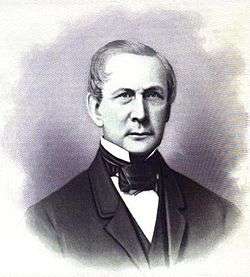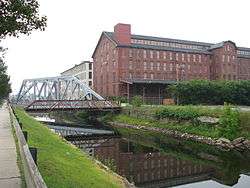Pemberton Mill
The Pemberton Mill was a large factory in Lawrence, Massachusetts, which collapsed without warning on January 10, 1860 in what is likely "the worst industrial accident in Massachusetts history"[1] and "one of the worst industrial calamities in American history".[2] An estimated 145 workers were killed and 166 injured.[3]
Description

The Pemberton Mill, built in 1853, was a five-story building 280 feet long and 84 feet wide.[1] Its chief engineer was Charles H. Bigelow and its construction was financed by John A. Lowell and his brother-in-law J. Pickering Putnam at a cost of $850,000, "a fortune for those times".[4][5]
During a financial panic in 1857, Lowell and Putnam sold the mill to George Howe and David Nevins, Sr. for a $350,000 loss. The new owners jammed more machinery into their factory attempting to boost its profits. The mill ran with great success, earning $1,500,000 per year, and had 2,700 spindles and 700 looms in operation at the time of the disaster.[5][6][7]
Collapse
Shortly before 5:00 p.m. on a Tuesday afternoon, workers in nearby factories watched with horror as the Pemberton Mill buckled and then collapsed with a mighty crash.[2] According to later court testimony reported by The New York Times, owner George Howe escaped as the structure was falling.[5]
Dozens were killed instantly and more than six hundred workers, many of them women and children, were trapped in the twisted ruins.[2] When the winter sun set, rescuers built bonfires to illuminate their efforts, revealing "faces crushed beyond recognition, open wounds in which the bones showed through a paste of dried blood, brick dust, and shredded clothing."[6]
Around 9:30 p.m., with many people still trapped in the twisted wreck of the factory, someone accidentally knocked over an oil lantern. Flames raced across the cotton waste and splintered wood — some of it soaked with oil.[6] One trapped man cut his own throat rather than be consumed by the approaching flames; he was rescued, but died from his other injuries.[8] As the fire grew, rescuers, physicians, families of the trapped victims, and spectators were all driven back by the conflagration.[6] The screams coming from the ruins were soon silenced, leaving rescuers to eventually discover only the burned, smoldering remains of "brick, mortar and human bones ... promiscuously mingled".[6]
The Boston Almanac and Business Directory notes the event by describing that:
The Pemberton Mills at Lawrence, Mass., ... (did) fall-in while nearly 800 operatives are at work, and bury many in the ruins. About four hours after the fall, a fire breaks out, and destroys those not extricated from the ruins. More than 115 people perish by the awful catastrophe, and 165 are more or less injured.[1]
The Boston Globe describes the carnage more vividly:
The scene after the fall was one of indescribable horror. Hundreds of men, women, and children were buried in the ruins. Some assured their friends that they were uninjured, but imprisoned by the timbers upon and about them. Others were dying and dead. Every nerve was strained to relieve the poor unfortunates, when, sad to relate, a lantern broke and set fire to the wreck. In a few moments the ruins were a sheet of flames. Fourteen are known to have been burned to death in the sight of their loved ones, who were powerless to aid them.
American Heritage magazine gives this account of the late-afternoon disaster:
Suddenly there was a sharp rattle, and then a prolonged, deafening crash. A section of the building's brick wall seemed to bulge out and explode, and then, literally in seconds, the Pemberton collapsed. Tons of machinery crashed down through crumpling floors, dragging trapped, screaming victims along in their downward path. At a few minutes after five, the factory was a heap of twisted iron, splintered beams, pulverized bricks, and agonized, imprisoned human flesh.[6]
Victims
Estimates of the number killed by the collapse and subsequent fire vary from 90[6] to 145.[3] Most were recent immigrants, either Irish or Scots,[5] many of them young women.[1] A 2002 fictionalization of the disaster recounted:
Flames spread rapidly, and now terror of fire threatened those waiting to be saved. Mary Bannon, pinned in the wreckage, handed her pay envelope to the friend comforting her and asked that it get to her father. 'Bid him goodbye for me,' she said, 'You will be saved; I will not'.[1]
While Irish and Scots were the majority, the list of the Pemberton Mill's casualties is indicative of New England's labor force at that time. There were also Yankees from Maine and New Hampshire, immigrants from Germany and Switzerland, and others. All the churches of Lawrence — Baptists, Catholic, Congregationalist, Episcopalian, Methodist, Presbyterian, Unitarian, and Universalist — had parishioners to console after the disaster.[6]
Aftermath

The collapse of the Pemberton Mill was determined to have been caused by a number of preventable factors. Ignoring already questionable load limits, extra heavy machinery had been crowded into the upper floors of the factory. Investigators also discovered substandard construction. The brick walls were improperly mortared and supported. The iron pillars supporting the floors were cheap and brittle but had been installed nonetheless.[1][6]
In the wake of the disaster, area ministers delivered "sermons on God's inscrutable wrath" but it was apparent that blame lay in the manner in which the factory was built and operated.[6] The Scientific American wrote, "...there is now no doubt that the fall of the building was owing to the most gross negligence and want of fidelity in casting the columns."[9] The tragedy became a rallying point for efforts to improve safety standards in industrial workplaces.[1] It also inspired the popular sketch "The Tenth of January" by author Elizabeth Stuart Phelps Ward.[10]
David Nevins, Sr. bought out his partner and rebuilt the mill. After his death it passed to his sons, David Nevins, Jr. and Henry Cotton Nevins.[5][7][11] The mill still stands today.
See also
- Tourlawrence - a location-based documentary and interactive history trail about two sisters who worked in the Pemberton Mill in 1860.
- 2013 Savar building collapse - the deadliest industrial accident in history
- Grover Shoe Factory disaster
- List of industrial disasters
Bibliography
- Little, George P. (1860). The Fireman's Own Book, Chapter: Destruction of the Pemberton Mills, Lawrence, Mass. pp. 247–255. Retrieved 2009-06-13.
- Oickle, Alvin F. Disaster in Lawrence: The Fall of the Pemberton Mill. Charleston, South Carolina: History Press, 2008. ISBN 978-1-59629-506-3.
References
- Pemberton Mill Collapse, 1860
- "Disaster in Lawrence: The Fall of the Pemberton Mill, by Alvin F. Oickle". Archived from the original on 2012-07-23. Retrieved 2008-08-10.
- "THE FALL OF THE PEMBERTON MILL". The New York Times. April 18, 1886.
- The Pemberton Mill Disaster of 1860
- THE DISASTER AT LAWRENCE. Additional Testimony-Further Subscriptions -Progress in Relieving the Sufferers New York Times, January 21, 1860
- THE WORKING LADIES OF LOWELL American Heritage Magazine
- Genealogical and Personal Memoirs Relating to the Families of Boston and Eastern Massachusetts, William Richard Cutter, Lewis historical publishing company, 1908
- Dyer, John J. (1860). An authentic history of the Lawrence calamity ... Boston: J.J. Dyer. p. 15. Retrieved 2009-01-10.
- The Pemberton Mill to be Re-built Scientific American
- Shelton, Pamela L. Feminist Writers. St. James Press, 1996: 382. ISBN 1558622179
- Official Website of the City of Methuen